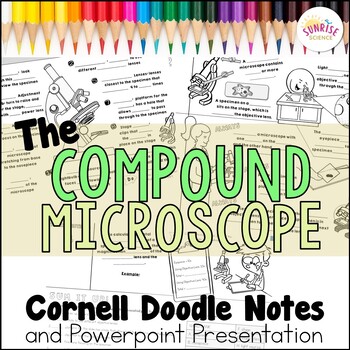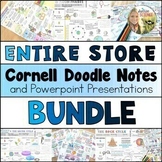Microscope Doodle Notes | Middle School Science | Cornell Notes
- Zip
What educators are saying
Also included in
- This is a growing bundle of ALL of my Science Cornell Doodle Notes resources. This bundle currently contains Cornell Doodle Notes and the associated Powerpoint / Google Slides Presentations for 48 science topics. The price at this point reflects what is in the bundle at this time, plus 20% off. As aPrice $189.00Original Price $244.25Save $55.25
Description
These scaffolded Cornell Doodle Notes combine two effective note-taking strategies and can be used to introduce the parts, their functions, and the use of the compound microscope. These notes provide a graphic organizer of the parts and functions of the microscope, a summary of how the microscope magnifies an image, rules for using a microscope safely and properly, and steps for calculating a compound microscope’s total magnification power.
As a review at the end of the notes, there is a Sum It Up section included that asks students to match the microscope functions with each part. There is also a microscope diagram on which students can label the microscope parts. This can also be used as a quiz.
Cornell Notes are a note-taking strategy in which topic questions are written in a narrow left-hand column and definitions, explanations, and diagrams are filled in in the right-hand column.
Doodle Notes (or Sketch Notes) are another note-taking strategy for which pictures and graphics activate the visual pathways of the brain, which helps with retention of information when compared to standard note-taking. Your visual learners will really benefit from seeing and coloring in the pictures aside the main points of the notes!
I created a Powerpoint that goes with these notes. The Powerpoint walks the students through the lesson from the Essential Question and through all of the Topic Questions. Students can use the Powerpoint (or the Google Slides version) to complete their individual notes. At the end of the lesson, the students can try the vocabulary matching practice in the Sum It Up section. Note: teacher can optionally delete the red arrows in the Powerpoint/Slides if that would be more suitable for the lesson.
The Cornell Doodle Notes are 3-pages and there are 3 scaffolded versions plus the answer key included. There are also leveled microscope diagrams for labeling included as a 4th page for each student.
The Powerpoint is included and there are also directions for accessing the presentation via Google Drive (Google Slides). This is obviously optional depending on how you choose to use this in your classroom.
Learn how to separate the differentiated versions of these notes in your Google Drive and how to assign them digitally using Google Classroom by downloading THIS FREEBIE!
Here are some ways that I suggest using this product:
✎ Whole-Group lesson with scaffolding : decide which students should receive which level of the notes. Hand out the notes to the students. Use the Powerpoint as a presentation and talk aloud through the lesson while the students take notes. Allow them to color/doodle further after each section and at the end of the lesson. {If you have a document camera (an ELMO), you can fill out your own notes and the students can follow along with you as you discuss the concepts aloud!}
✎ Scaffolded Small-Group lesson : separate your students into groups by learning level. Give each student group sets of the appropriate notes for their level. Make sure each group has a device to view the presentation. Post the Powerpoint or Google Slides to your Google Classroom or other online learning platform, or email the Powerpoint version to one ‘student leader’ in each group. The students would view the Powerpoint/Slides together on one device and fill in the notes. . Encourage them to add color/further notes.
✎ Individual Note-Taking or Flipped Classroom : Post the Powerpoint to your Google Classroom or other online learning platform or hand out the Google access directions to your students.. Hand out the appropriate-level notes to each student. Students can work at their own pace to view the presentation and complete their notes. Encourage them to add color/further notes.
Please note that this resource is not editable due to font and clip art licensing agreements.
Doodle notes is a trademarked term used with permission. Please visit doodlenotes.org for more information.
You may also be interested in these resources:
Microscope Licensing Test and Student Licenses
Cell Organelles Cornell Doodle Notes and Powerpoint
Photosynthesis Cornell Doodle Notes and Powerpoint
Thanks for looking!
Sunrise Science






